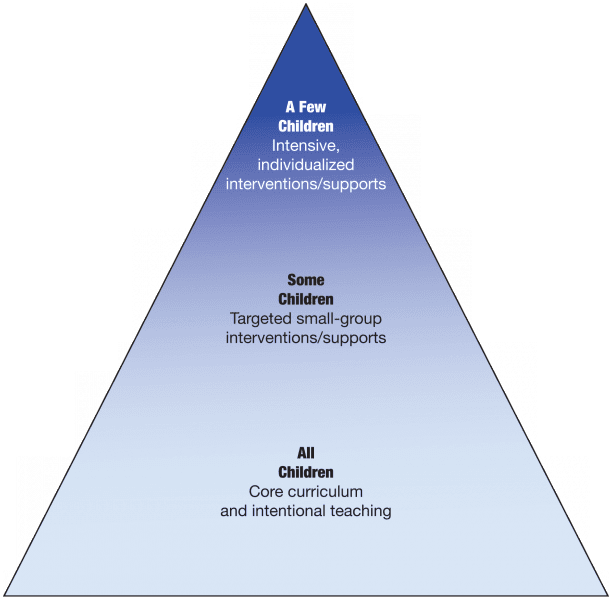Tiered instruction consists of both foundational practices that teachers use with all children as well as targeted interventions and supports that are used with some.
Central to tiered instruction is having an effective core curriculum and intentional teaching.
An effective core curriculum is one that is based on research evidence, is developmentally appropriate, and covers all domains of learning—for example, language, literacy, math, and social-emotional development.
Intentional teaching means the purposeful organization of the early learning environment and developmentally appropriate learning activities to help children develop and acquire important skills. In tiered instruction, the concept of intentional teaching is expanded to include targeted interventions for some children who require additional academic or behavioral supports, generally provided through small-group instruction, embedded learning activities, or individualized scaffolding.

Video 7.6: Tiered Instruction Framework
A framework for tiered instruction that can be used in early childhood settings is discussed (running time: 1 min., 57 sec.).
View Transcript
Narrator:
Tiered instruction is a framework for linking assessment with instructional and behavioral supports that are matched to children’s learning needs. One way to understand the meaning of tiered instruction, is to consider how you might build this approach in your own early childhood classroom or program.
You would start by making sure that you have the foundational elements in place to support the development and learning of all children. These foundational elements include having a comprehensive core curriculum, along with intentional teaching, and multiple opportunities throughout the day for children to learn key concepts and skills. In addition, to address children’s social-emotional development, you would include strategies focused on building strong relationships with children and families, and program staff, and ensure that the classroom offers a positive learning environment in which children feel connected and safe.
Next, you would add a layer of targeted interventions and behavioral supports for some children who need these additional supports to learn. These interventions and supports could include, for example, providing small-group lessons for some children to reinforce key language and literacy skills introduced in the core curriculum, or creating an incentive system for a child who is having difficulty getting along with peers or following directions. A few children might need more intensive, individualized interventions and supports. These intensive interventions and supports could include, for example, prompting, modeling, and peer supports to reinforce academic learning goals, or an individualized behavior support plan to address a child’s challenging behaviors.
It is important to note that tiered instruction is intended to show how early educators can organize instruction, interventions, and supports by level of intensity, as opposed to labeling children or placing them in tiers. In other words, tiered instruction offers a framework for thinking about the level of adult involvement needed to support the learning and development of all children.

